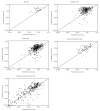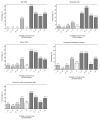Visual acuity after cataract surgery in patients with age-related macular degeneration: age-related eye disease study 2 report number 5
- PMID: 24613825
- PMCID: PMC4047168
- DOI: 10.1016/j.ophtha.2013.12.035
Visual acuity after cataract surgery in patients with age-related macular degeneration: age-related eye disease study 2 report number 5
Abstract
Objective: To evaluate visual acuity outcomes after cataract surgery in persons with varying degrees of severity of age-related macular degeneration (AMD).
Design: Cohort study.
Participants: A total of 1232 eyes of 793 participants who underwent cataract surgery during the Age-Related Eye Disease Study 2, a prospective, multicenter, randomized controlled trial of nutritional supplements for treatment of AMD.
Methods: Preoperative and postoperative characteristics of participants who underwent cataract extraction during the 5-year trial were analyzed. Both clinical data and standardized red-reflex lens and fundus photographs were obtained at baseline and annually. Photographs were graded by a centralized reading center for cortical and posterior subcapsular lens opacities and for AMD severity. Cataract surgery was documented at annual study visits or by history during the 6-month telephone calls. Analyses were conducted using multivariate repeated-measures regression.
Main outcome measures: Change in best-corrected visual acuity (BCVA) after cataract surgery compared with preoperative BCVA.
Results: Adjusting for age at time of surgery, gender, interval between preoperative and postoperative visits, and type and severity of cataract, the mean changes in visual acuity were as follows: eyes with mild AMD (n = 30) gained 11.2 letters (95% confidence interval [CI], 6.9-15.5), eyes with moderate AMD (n = 346) gained 11.1 letters (95% CI, 9.1-13.2), eyes with severe AMD (n = 462) gained 8.7 letters (95% CI, 6.7-10.7), eyes with noncentral geographic atrophy (n = 70) gained 8.9 letters (95% CI, 5.8-12.1), and eyes with advanced AMD (central geographic atrophy, neovascular disease, or both; n = 324) gained 6.8 letters (95% CI, 4.9-8.8). The visual acuity gain across all AMD severity groups was statistically significant from preoperative values (P < 0.0001).
Conclusions: Mean visual acuities improved significantly after cataract surgery across varying degrees of AMD severity.
Copyright © 2014 American Academy of Ophthalmology. Published by Elsevier Inc. All rights reserved.
Figures



References
-
- Eye Diseases Prevalence Research Group Prevalence of age-related macular degeneration in the United States. Arch Ophthalmol. 2004;122:564–72. - PubMed
-
- Eye Diseases Prevalence Research Group Prevalence of cataract and pseudophakia/aphakia among adults in the United States. Arch Ophthalmol. 2004;122:487–94. - PubMed
-
- Brody BL, Gamst AC, Williams RA, et al. Depression, visual acuity, comorbidity, and disability associated with age-related macular degeneration. Ophthalmology. 2001;108:1893–900. - PubMed
-
- Tseng VL, Yu F, Lum F, Coleman AL. Risk of fractures following cataract surgery in Medicare beneficiaries. JAMA. 2012;308:493–501. - PubMed
-
- Pollack A, Marcovich A, Bukelman A, Oliver M. Age-related macular degeneration after extracapsular cataract extraction with intraocular lens implantation. Ophthalmology. 1996;103:1546–54. - PubMed
Publication types
MeSH terms
Substances
Grants and funding
LinkOut - more resources
Full Text Sources
Other Literature Sources
Medical
Molecular Biology Databases

